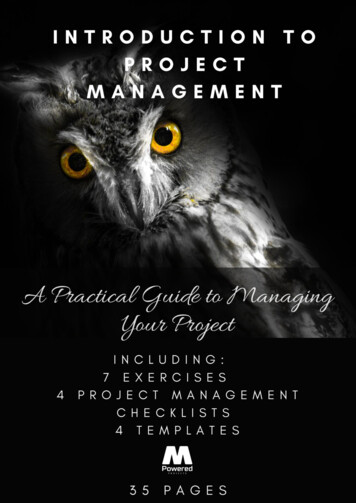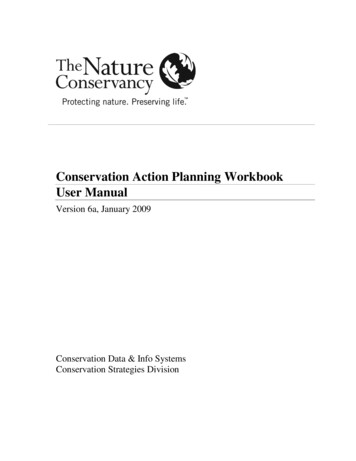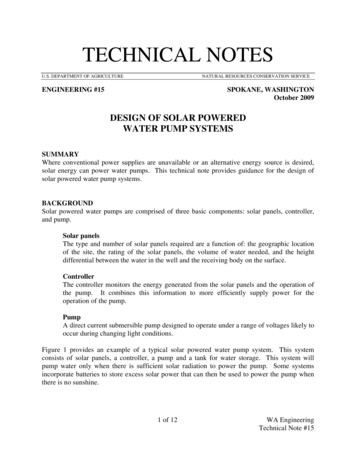
Transcription
The workbookThe workbook is designed in such a way that you can use it independently.However, it will be much more enjoyable and productive if you carry out theseexercises with your project team and use them to stimulate discussion aboutproject management standards in your organisation and project consortium.You will learn about: Organisational structure and how to use it to your advantage Project lifecycle Phases of a project and useful checklists to manage them Project timeline A work breakdown structure to help plan your budget Project constraints The role of a project manager—soft and hard skills Creating a project management handbook and a practical projectmanagement map.You will also find some useful documents on our website that will help you to setup your own project management system: 4 Excel project management checklists A Project-programme-portfolio tree that you can print and use during ameeting with your project team Project management handbook templates.Good luck!M-Powered team2
Table of contents1. Projects, programmes, and portfolios . 42. Project lifecycle . 93. Project timeline . 164. Work breakdown structure and budget . 195. Constraints .226. Project manager . 257. Project Management Handbook and map. 303
1. Projects, programmes, and portfoliosA project is a temporary undertaking to create a unique product, service, orresult1. Projects are critical for the change and development of manyorganisations, but they are different from everyday operational work, and areoften more challenging to manage.A programme is a group of related projects that are being managed ina coordinated way to reach goals, which would not be accessible throughmanaging these projects individually.A portfolio refers to programmes and projects managed by an organisation toachieve strategic goals.From our experience, not many organisations involved in projects use theproject-programme-portfolio structure or “tree”. There is, however, an advantagein applying this structure in your organisation: it helps to decide which projectsthe organisation should get involved in to achieve its strategic goals. With thisapproach, each programme refers to a specific strategic goal of the organisation.A simple project-programme-portfolio tree may look as PROJECT1A Guide to the Project Management Body of Knowledge (PMBOK Guide) (5th ed.) (2013) ProjectManagement Institute4
A more complex project-programme-portfolio tree could include a single projectthat spans more than one programme. Such structures vary in organisations.However, the key point is to understand why we take on projects and how theyfit into the strategic goals of our organisation.Exercise No. 1Project-programme-portfolio treeThis exercise will help you to build your organisation’s project-programmeportfolio tree. The goal of this exercise is to help you to put a framework on thevarious projects in which your organisation is involved and understand how theprojects meet your strategic objectives.You can do this exercise directly into the workbook by printing out the followingpage and drawing your own project-programme-portfolio tree. This may workbest if you are doing it alone. Alternatively, and especially if you are doing thiswith a team, you can draw out a full size diagram using a flipchart. If you decideto do a full size diagram, you will need: Cards in three colours: project cards, programmes cards, and a portfoliocard. On our website you will find templates of these cards. Just printthem out and cut them to size A blank piece of flipchart paper Glue A crayon or a marker.Your first task is to think about the main strategic goal or goals of yourorganisation. Does it want to change the primary school education system inyour country, or improve the wellbeing of seniors in your city? Try to be specific.Write the goal or goals on a portfolio card and paste it at the top of a blank pieceof paper.Now, on the separate project cards, list all the projects your organisation isinvolved in (or at least the projects you are aware of). Describe them briefly.5
Have a closer look at the project cards you have filled out. Is there a patternthere? Can you group them? Do they belong to different programmes? Take theprogrammes cards and title them accordingly. Paste them under the portfoliocard and group the projects on the page according to the programme to whichthey belong.Some projects may not belong to programmes or there may be some overlap.Takea crayon or a marker and draw lines between the portfolio, programmes, andprojects, indicating any links that exist between them.If you do this exercise with a team, discuss your project-programme-portfoliotree with each other. Which projects and programmes are the most important foryour organisation, your colleagues, and you, personally? Is there anythingmissing in your or your colleagues’ trees? Should your organisation get involvedin different projects to achieve its strategic goals?6
PROJECT:nameDescription:PROGRAMME:nameObjective of the programme:PORTFOLIO:nameStrategic goal(s) of the organisation:7
Your tree8
2. Project lifecycleThere are different types of projects. Some of them last a couple of months,others go on for many years. However, all of them have a similar lifecycle.The following graph depicts a project lifecycle that is typical for Europeanprojects, but can apply to many others:9
Exercise No. 2Project manager’s tasksWhat do you think the project manager’s tasks are at each project lifecyclestage? Write them down:Preparation of a project proposal:Preparation of a project management handbook:10
Project implementation:Preparation of final reports and lessons learned:Reviewing the exerciseAfter completing your list of project management tasks, go to pages 13 – 16 andcheck your answer against the project management checklist provided. Have youcovered all of them? Which ones did you miss? Do you think they are importantand why?In our M-Powered Project Management workbooks, we explain each phase indetail and walk you through a system for how to make project managementeasier and more effective.11
Project managers often overlook the preparation phase, which follows projectapproval. They believe that a project application, which usually contains dozens,if not hundreds, of pages, will be a sufficient reference tool for the project teamand the important stakeholders involved. This is a mistake.Let us think about the thick, unfriendly, and bureaucratic documents that aresubmitted to attain grants or sponsors’ approval. How easy are they to read?Bear in mind that if you are planning an international project, most teammembers will not be native speakers of the project application language. Howaccessible are these documents to all involved?The truth is that these documents are usually quite laborious to read, and there islittle chance that your project team will analyse them carefully. Moreover, theseapplications tend to have just one brief section dedicated to project managementprocesses.Therefore, it is important that you, as a project manager, adapt the projectapplication into a more friendly, accessible and practical document, which we atM-Powered call a project management handbook. This handbook should describeproject objectives, duration, resources, partner organisations, timeline, andactivities, as well as plans for human resources, communications, stakeholders,quality, risk, and change management.In this workbook, you will find many tools and ideas that will help you to writeyour own project management handbook.In the next sections you will find four checklists. They will help you to ensure thatall necessary tasks are completed at every stage of the project lifecycle. You canalso download these checklists as excel documents from our website.12
Project preparation checklistThe project idea is aligned with my organisation’s strategic goals.To verify this, check that the idea fits into your organisation’s Project-ProgramPortfolio structure. You should be able to explain why this project is necessaryand how it complements and supports your existing work.The project proposal meets the priorities and objectives of the grantprogramme, e.g. European programme (if applicable) or funder priorities.The project proposal corresponds with all formal criteria specified by thefunder.I researched the target group. I know who they are and what their needs are.The project goal is to answer those identified needs.I have built a strong partnership with other organisations (if applicable).I organised a (virtual) meeting with them to explain the project idea.Partners contributed to the project application.Partners accepted the project application and the budget beforesubmission.I made a project timeline.I have put structure to the project by breaking it down into tasks, activities, orwork packages.The budget is reasonable and correlates to the project structure created.The main project components (goals, budget, partner roles) were approved bythe management of my organisation.The project application was checked by an additional person beforesubmission.13
Preparation of a project management handbook checklistI let the partners know that the project was approved (if applicable).I scheduled a kick-off meeting.I prepared a project management handbook which contains:Project information,Project team structure and management plan,Conflict resolution strategy (formulated with the project team,ideally at the kick-off meeting),Communication strategy (formulated with the project team,ideally at the kick-off meeting),Risk management plan (formulated with the project team,ideally at the kick-off meeting),Change management plan,Stakeholder management plan,Quality control and monitoring tools.The project management handbook was sent to all the partners before thekick-off meeting.The project management handbook was updated with the results of the kickoff meeting and was accepted by the partners and all the relevantstakeholders.14
Project implementation checklistThis checklist is a monitoring tool that you can use periodically, e.g. monthly,quarterly. The frequency depends on your project schedule.Kick-off meeting conducted.Project management handbook was accepted by each partner.I created a project glossary together with the team.Other project meetings are organised according to the project plan.I execute work according to the project plan.I monitor activities, tasks and work-packages/intellectual outputs regularly andaccording to the project plan.Project deliverables are approved by a steering committee.Sponsor (EU agency) receives regular reports (as planned in the projectproposal).I regularly manage stakeholders’ engagement and expectations.I regularly monitor project team engagement.I created and implemented a communication plan.I conducted risk management workshops with relevant stakeholders andcreated a risk response strategy.I monitor risks regularly.I monitor budget regularly.I monitor the process of delivering the assumed results and outcomes.I perform quality control.I monitor work-life balance in both myself and my team (more in Chapter 6).I requested changes if applicable and implement only approved changes.15
Preparation of final reports and lessons learnt checklistI expressed gratitude to team members and engaged stakeholders, includingproviding recognition and rewards.I conducted a lessons learnt workshop.I gathered final lessons learnt and updated our knowledge base accordingly.The budget and deliverables were accepted by the steering committee.Final reports were prepared, checked by at least one proof-reader, andsubmitted.Project documentation was archived according to organisational rules and willbe easily accessible in the case of an audit or for any other purpose.These checklists give you an overview of the most critical tasks of a projectmanager. In the next chapters, you will find descriptions of tools that will helpyou to properly manage a full project lifecycle.3. Project timelineA picture says more than a thousand words.A project timeline is a visual image of project activities, meetings, events, andmanagement processes.16
A sample project timeline:
Exercise No. 3Your timelinePrepare a timeline for your project:
4. Work breakdown structure and budgetA work breakdown structure (WBS) is the next step after a timeline. Once you knowroughly what must be done and how much time it will take, you can start breakingdown work packages into tasks, which will be allocated to different partnerorganisations or team members. It helps to allocate a budget to a specific task.PROJECTWP 1WP2Task 1Task 1Task 2Task 2Task 3Task 3Task 4As an example, let’s imagine you are organising a wedding. What kind of groups oftasks can you imagine? The following are some suggestions:Work Package 1: ChurchTask 1: Set a wedding dateTask 2: Meet the celebrantTask 2: Book a musicianTask 3: Book a florist19
Work Package 2: The brideTask 1: Get a wedding dressTask 2: Book a hairdresserTask 3: Book a make-up artistWork Package 3: The groomTask 1: Get a tuxedoTask 2: Book a barberYou can go on with the list, for example, by going
The workbook The workbook is designed in such a way that you can use it independently. However, it will be much more enjoyable and productive if you carry out these exercises with your project team and use them to stimulate discussion about project management standards in your organisation and project consortium. You will learn about: Organisational structure and how to use it to your .










